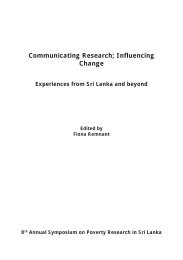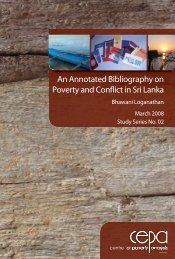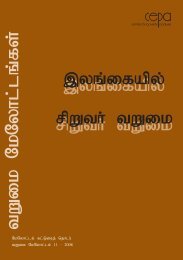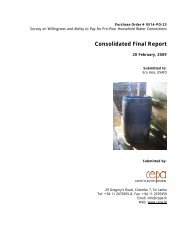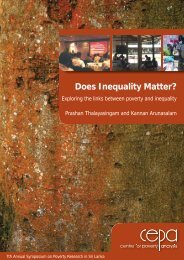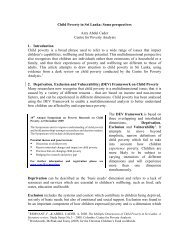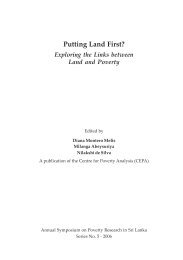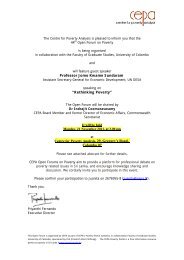Involuntary Displacement and Resettlement â Policy and ... - CEPA
Involuntary Displacement and Resettlement â Policy and ... - CEPA
Involuntary Displacement and Resettlement â Policy and ... - CEPA
- No tags were found...
Create successful ePaper yourself
Turn your PDF publications into a flip-book with our unique Google optimized e-Paper software.
1 IntroductionWorldwide experience demonstrates that most development projects whichdisplace people create severe economic, social <strong>and</strong> environmental problems.They aggravate poverty by dismantling production systems; relocatingpeople to unfriendly environments where their productive skills may be lessapplicable <strong>and</strong> the competition for resources much greater; weakeningcommunity structures <strong>and</strong> social networks; <strong>and</strong> dispersing kin groups <strong>and</strong>diminishing cultural identity, traditional authority, <strong>and</strong> the potential formutual help. <strong>Involuntary</strong> resettlements usually cause severe long-termhardship, impoverishment, <strong>and</strong> environmental damage unless carefullyplanned <strong>and</strong> executed. It is now widely accepted that people should be atthe centre of any development activity, <strong>and</strong> such activity should aim toenhance the quality of their lives <strong>and</strong> address poverty. During the last fourdecades, thous<strong>and</strong>s of families have been involuntarily resettled in SriLanka, mainly to facilitate irrigation, highway <strong>and</strong> urban developmentprojects, <strong>and</strong> the majority of them have been low income families. Untilrecently, development-induced displacement of population was considered a‘sacrifice’- with a comparatively small group of people displaced for thebenefit of a larger number of people. What these involuntary resettlersreceived as compensation, in general, was limited to statutory monetarycompensation for l<strong>and</strong> <strong>and</strong> houses acquired for the project, provided thatlegal ownership could be proved, generally resulting in making poor <strong>and</strong>l<strong>and</strong>less people even poorer <strong>and</strong> more vulnerable.The Project Affected Persons (PAPs) based, pro-poor development-induced<strong>and</strong> participatory <strong>Involuntary</strong> <strong>Resettlement</strong> Program, implemented by theLunawa Environment Improvement & Community Development Project(LEI&CDP), sought to ensure the tenure rights of the poor living in slum <strong>and</strong>shanty settlements in the Lunawa catchments. The project was launched in2002 with the objective of improving the environment <strong>and</strong> quality of life ofpeople by improving the storm water drainage systems in the Lunawa basin.The National <strong>Resettlement</strong> <strong>Policy</strong> (NIRP) was adopted by the government in2001, after the design phase of the LEI&CPD, <strong>and</strong> the scope of the projecthad to be revised, incorporating the NIRP principles, with UN-HABITATtechnical inputs <strong>and</strong> with additional funding by the government.This paper documents the key elements of an innovative implementationprocess of resettlement.148



